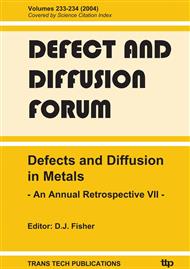[1]
A. D. Smigelskas and E. O. Kirkendall: Trans. AIME Vol. 171 (1947), p.130.
Google Scholar
[2]
L.S. Darken: Trans AIME Vol. 175 (1948), p.184.
Google Scholar
[3]
P.G. Shewmon: Diffusion in Solids (McGraw-Hill Book Company, USA 1963).
Google Scholar
[4]
J.R. Manning: Diffusion Kinetics for Atoms in Crystals (D. Van Nostrand Company, Inc, Princeton, USA 1968).
Google Scholar
[5]
J.S. Kirkaldy and D.J. Young: Diffusion in the Condensed State (The Institute of Metals, London, UK 1987).
Google Scholar
[6]
J. Philibert: Atom Movements, Diffusion and Mass Transport in Solids ( Les Éditions de Physique, Les Ulis, France 1991).
Google Scholar
[7]
A.R. Allnatt and A.B. Lidiard: Atomic Transport in Solids (Cambridge University Press, UK 1993).
Google Scholar
[8]
M.E. Glicksman: Diffusion in Solids (John Wiley & Sons, Inc, New York, USA 2000).
Google Scholar
[9]
C. Matano: Japan J Physics Vol. 8 (1933), p.109.
Google Scholar
[10]
F. Sauer and V. Freise: Z Elektrochem Vol. 66 (1962), p.353.
Google Scholar
[11]
M.J.H. van Dal, M.C.L.P. Pleumeekers, A.A. Kodentsov and F.J.J. van Loo: Acta mater Vol. 48 (2000), p.385.
Google Scholar
[12]
M.J.H. van Dal, A. M. Gusak, C. Cserháti, A. A. Kodentsov and F.J.J. van Loo: Phys Rev Lett Vol. 86 (2001), p.3352.
DOI: 10.1103/physrevlett.86.3352
Google Scholar
[13]
M.J.H. van Dal, A.M. Gusak, C. Cserháti, A.A. Kodentsov and F.J.J. van Loo: Phil Mag A Vol. 82 (2002), p.943.
Google Scholar
[14]
Y. Chang, I. Gyuk and J. Franks: Acta Met Vol. 19 (1971), p.939.
Google Scholar
[15]
C. Kao and Y. Chang: Intermetallics: Vol. 1 (1993), p.237.
Google Scholar
[16]
A. Paul, A. Kodentsov and F. van Loo: Acta mater Vol. 52 (2004), p.4041.
Google Scholar
[17]
M.J.H. van Dal, D.G.G.M. Huibers, A.A. Kodentsov and F.J.J. van Loo: Intermetallics Vol. 9 (2001), p.409.
Google Scholar
[18]
C. Wagner: Acta Met Vol. 17 (1969), p.99.
Google Scholar
[19]
M.J.H. van Dal, A.A. Kodentsov, F.J.J. van Loo: Intermetallics Vol. 9 (2001), p.451.
Google Scholar
[20]
P. Villars and L. Calvert: Pearson's Handbook of Crystallographic Data for Intermetallic Phases (American Society for Metals, Ohio, USA 1985).
Google Scholar
[21]
F.J.J. van Loo, B. Pieraggi and R.A. Rapp: Acta metall mater Vol. 38 (1990), p.1769.
Google Scholar
[22]
A. Paul, M.J.H. van Dal, A.A. Kodentsov and F.J.J. van Loo: Acta mater Vol. 52 (2004), p.623.
Google Scholar
[23]
F.J.J. van Loo: Diffusion in the Titanium - Aluminium System ( PhD Thesis, Eindhoven, The Netherlands 1971).
Google Scholar
[24]
F.J.J. van Loo and G.D. Rieck: Acta Met Vol. 21 (1973), p.73.
Google Scholar
[25]
T. Ikeda, H. Kadowaki and H. Nakajima: Acta mater Vol. 49 (2001), p.3475.
Google Scholar
[26]
V.I. Dybkov: Growth Kinetics of Chemical Compound Layers (Cambridge International Science Publishing, UK 1998).
Google Scholar


